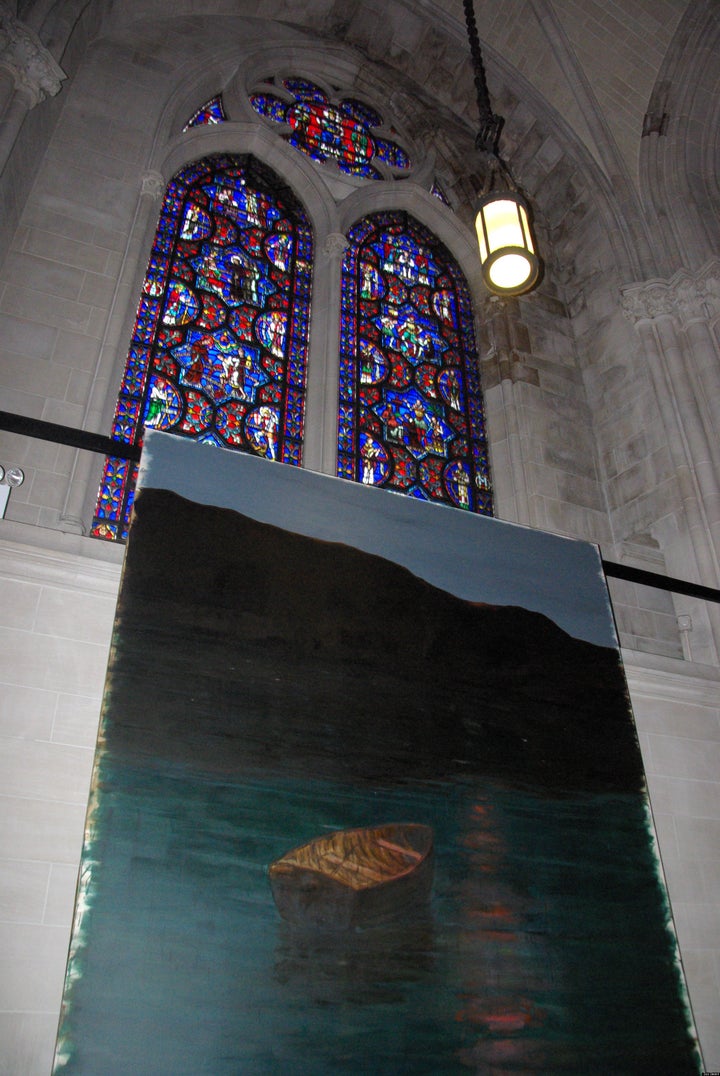
One way of reading the slowly cooling controversy over the Smithsonian's removal of David Wojnarowicz's "A Fire in My Belly" video is that it was desperately necessary. In the attacks and defenses, the protests and petitions, one sensed a palpable relief. Finally, the art world was back to normal. Religious people got angry; the culturati got angry. It was Mapplethorpe's Concoran and Ofili's Sensation all over again. The players took their places, the scripts were handed out, the media yelled "Action!" and everyone knew what to do. Senator Jesse Helms was replaced with Representative John Boehner, and Andres Serrano was replaced with Wojnarowicz, though it wasn't urine on the crucifix this time. It was ants.
But as the media scans for the next controversy, having drained this one of its potential, a more positive art world development endures: The return of religion as a serious concern. Two shows closing this month told a far different story than have the season's cultural headlines. First was Enrique Martínez Celaya's exhibit at Manhattan's Museum of Biblical Art, entitled "The Wanderer," in conjunction with a parallel installation at the Episcopal Cathedral of St. John the Divine entitled "The Crossing." Martínez Celaya's paintings and sculptures at MOBIA were anything but straightforwardly religious -- they were gravid with mystery and doubt. But they were presided over by shelves of antique Bibles, as if to remind the viewer that the Scriptures themselves pose similar questions. Likewise, the paintings installed at St. John the Divine contrasted early 20th century stained glass that celebrated Christian civilization, with the brooding interrogations of a God-haunted artist. Art and religion, both Martínez Celaya's installations seemed to suggest, can help one another succeed.
Ironically, Makoto Fujimura's exibition, "The Four Holy Gospels," though more explicitly religious, inhabited the supposedly secular Chelsea district at the Dillon Gallery (though reappearing at the MOBIA this summer). The paintings show just how far "evangelical" artists have come, from Timothy R. Botts' calligraphic transcriptions of Bible verses, to Fujimura's airily abstract, wordless meditations on the Holy Writ. Fujimura, a member of Manhattan's Redeemer Presbyterian Church, came to faith as a painter and has made a career of showing Protestants how faith and art can be symbiotic. Neither Martínez Celaya's nor Fujimura's show received overwhelming press, but those who visited them were assured that far more interesting things are afoot than an art world/Republican party standoff.
While the Smithsonian controversy made it seem like art and religion could never be more distanced, the truth is that religion has become an increasing point of artistic concern. Art historians, to be sure, have long ignored the last century's religious art, but such a tiresome approach is recently being itself ignored. The title of Yale art historian Sally Promey's article says it all: "The 'Return' of Religion in the Scholarship of American Art." Likewise, it's no mere coincidence that the Art Seminar series, a major forum in the fields of art and art history, concluded with a volume on religion, entitled "Re-Enchantment," questioning why religious concerns have been unjustly excluded from the world of art. Most recently, a symposium designed to continue this line of investigation, entitled "Why Have There Been No Great Modern Religious Artists?" is scheduled alongside the meeting of the College Art Association in Manhattan next month. The Symposium aims to challenge the "narratives of modernist and post-modernist art history that have tended to omit serious consideration of Christian strains in 20th century and current artistic practice." Art's chilly attitude toward religion is thawing, expressed perhaps most directly by Harvard's Camille Paglia:
I would argue that the route to a renaissance of the American fine arts lies through religion. Let me make my premises clear: I am a professed atheist and a pro-choice libertarian Democrat. ... For the fine arts to revive, they must recover their spiritual center. Profaning the iconography of other people's faiths is boring and adolescent. The New Age movement, to which I belong, was a distillation of the 1960s' multicultural attraction to world religions, but it has failed thus far to produce important work in the visual arts.
To be sure, the art world suffers from a secular hangover still. But one can't shake the feeling that religious concerns are the elephant in the gallery, waiting to be more fully addressed. When the dust settles from the controversy over Wojnarowicz (whose work should be understood apart from it), this refreshing proximity of art and religion, not their temporary alienation, will endure.
At the end of the day, the silliest part of the passing kerfuffle is that it betrays a fundamental misunderstanding of Christianity. The cross, at least according to St. Paul (1 Corinthians 1:23), is already an intentional offense, and nothing done to it by artists can make it any more horrifying than it already, quite intentionally, is: The most hideous of spectacles, a hole impossibly black, absorbing every awful deed committed and every good one left undone. Just what is a crucifix? It's impossible to say: "As the depths of the sea cannot be fathomed by any human gaze," wrote Gregory of Nyssa, "so too the secret of Hell is impenetrable to all human knowledge." But such was the cost of redemption. Compared to the bracing reality of the gospel itself, urine and ants are as offensive as Champagne and butterflies.
Matthew Milliner is a Ph.D. candidate in art history at Princeton University. He blogs at millinerd.com.